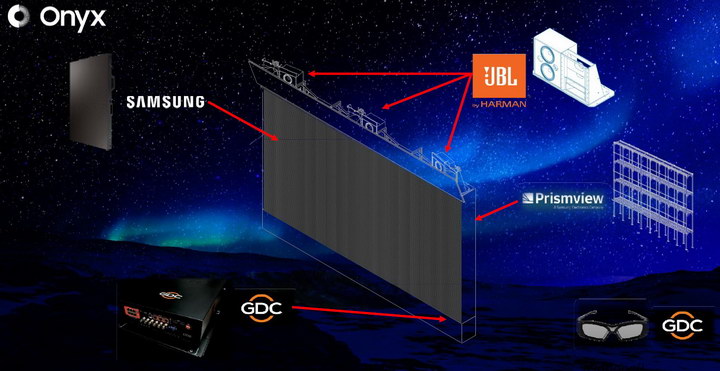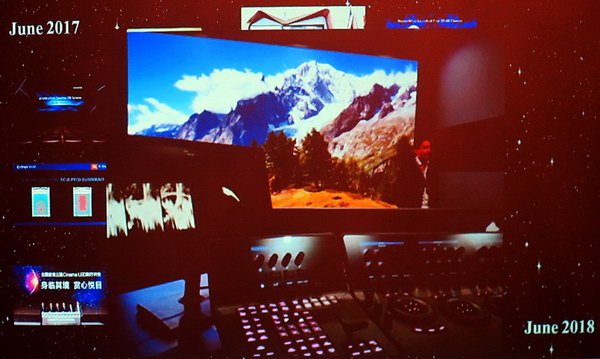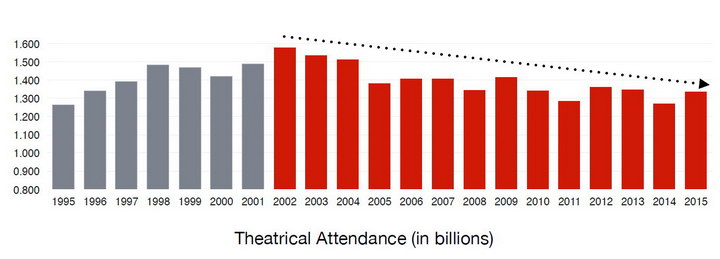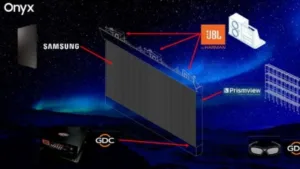The first speaker on the HDR Cinema topic was Christopher Buchanan of Samsung Electronics America titled The (LED) Future Starts Today. His talk was mostly a pep talk about LED Cinema especially, of course, Samsung’s Onyx LED cinema system. The Onyx system consists of more than just the LED video wall from Samsung. It also includes a DCI-compliant server and active 3D glasses from GDC Technologies; support from Prismview, a Samsung Electronics LED digital signage company; and a sound system from JBL. JBL is also a Samsung company, owned through its Harman subsidiary.
 The Samsung Onyx LED Cinema System (Source: Samsung at ADS)
The Samsung Onyx LED Cinema System (Source: Samsung at ADS)
Buchanan said there were two major content-related issues for LED digital cinema. First, since LED screens are capable of showing true black and have much higher contrast than even the best projectors, normally when the studio post-production process sets “Black” in the content, it sets a black level that is not true black, just darker than projectors can show. This then shows up on the LED screen as a dim but visible light level, not black. The second issue with LED screens is with the titles and credits, especially the scrolling credits on a black background that come at the end and typically list hundreds of people and organizations that have worked on the movie. These show up with excessive judder, believed to be due to the very high contrast ratio of the screen and its very high pixel-to-pixel MTF.
Both of these issues can be resolved in the post-production process, perhaps by using the Colorfront Engine discussed above. Buchanan is looking for the studios to develop a LED cinema master, not a Samsung LED Master. While Samsung may have been first into LED cinema, he believes they aren’t going to be the last. The very high resolution and contrast of a LED screen also makes other problems besides judder and black level visible in the image. Buchanan compared it to the transition from SD to HDTV. In SDTV, painted cardboard sets were fine but in HDTV they looked like, well, painted cardboard. This may force the studios to change how they make movies when LED screens become more common.
The very high quality image presented by a LED Cinema screen actually draws additional viewers into the theater, just as better sound and more comfortable stadium seating has drawn viewers. He added that previous, projector-based image quality improvements like the switch from film to digital and now the addition of RGB laser cinema to the mix have not drawn additional viewers. Cinema revenue has been stable but this is driven by higher ticket prices with lower attendance, not stable attendance.
 A Samsung Onyx screen being used in a color grading application. (Credit: Samsung at ADS)
A Samsung Onyx screen being used in a color grading application. (Credit: Samsung at ADS)
Buchanan said that Samsung expects to have about 30 LED cinema screens installed globally by the end of the year. He said there will be an announcement soon about a new multiplex that is being built with all Onyx LED screens and no projectors at all. Onyx screens are currently all 4K resolution and have a 2.5mm pitch for a 34’ (10.4M) screen. He said Samsung is working on a 3.3mm pitch Onyx screen that will produce a 46’ (14M) 4K cinema screen. He added that smaller 2K screens with these same pitches, and therefore half the size, are possible. These would be used in smaller venues and in post-production for the color-grading of cinema content, as shown in the image.
W. Thomas Wall gave a talk titled Impressions from Grading HDR on the Samsung Onyx Emissive LED Cinema Screen. Mr. Wall is a member of the SSIMWave HDR Evaluation Working Group and the American Society of Cinematographers (ASC) Motion Imaging Technology Council. Wall said that his talk represented personal impressions only and do not represent the position of either SSIMWave or the ASC.
As discussed by Buchanan (above), the final content grading and correction should be different for content targeted at LED screens than for content targeted at projection cinema screens. This was certainly verified by Wall’s experience.
 W. Thomas Wall speaking at the Advanced Display Summit (Credit: M. Brennesholtz)
W. Thomas Wall speaking at the Advanced Display Summit (Credit: M. Brennesholtz)
Samsung gave Wall a chance to do color grading of cinema content on a 5.15 m x 2.7m (16.9 x 8.85 feet) 2K Onyx LED screen installed at Roundabout Entertainment West (a post-production company) plus a Sony BVM-X300 and his talk was about this experience. He and five others were grading ASC HDR test material using ACES 1.1 tools. This content used SMPTE 2084 PQ encoding, was 24 fps and had full P3 color space.
The screen was set up for a peak brightness of 300 cd/m² and the minimum displayable brightness was 0.005 cd/m². (i.e. this was the brightness of bit 1) In the dark grading room, the displayed brightness with bit 0 (i.e. screen off) was effectively 0 cd/m². This gave a contrast ratio (dynamic range) of 60,000:1 (almost 16 stops, in a cinematographer’s parlance), compared to conventional cinema set up to 48 cd/m² with a black level of 0.05 – 0.02 cd/m² with contrasts of 960:1 – 2,400:1 (9.9 – 11.3 stops). Grading was done with 14 stops of dynamic range, 6 above and 8 below the 18% mid-gray point.
Most of Wall’s comments on this experience were related to the dark areas of the content, not the bright areas. He said, “from a cinematography perspective deep blacks with shadow detail all the way down are more important to image content and image impact than peak luminance but ~100 nits max is not high enough for fully effective HDR even in a dark room (and 300 nits peak is still not high enough for truly effective specular highlights).”
One additional comment he made on the dark regions of the content was that even with normal SDR cinema content, details were visible in the dark scenes that were not normally be visible with a projection system. In content for normal cinema, he said the blacks were often crushed but not visible. This crushing of blacks became visible on the LED cinema screen.
Another comment he made was that when bright scenes were shown with 200+ nit highlights, the light from the screen lit up the theater, making the other people and the inside of the theater visible. The very important cinema “suspension of disbelief” was broken by the ability to see the theater and other patrons. He also said 24Hz strobing was much more visible on the LED screen than on a projection screen. Strobing is always more visible at higher light levels and he pointed out that mid-gray on the 300 nit LED screen was brighter than the 48 nits achieved in cinema projection. He said this strobing is not subtle and would be clearly visible to patrons, not just trained colorists.
His final conclusion was “Cinematographers will need to start ‘thinking in HDR’ – when visualizing, planning, lighting, and shooting (not just when color grading in post). And so will VFX, and set design, and editing, and …”
He believes it is necessary to define a standard high dynamic range for cinema which he suggests be called Cinema HDR. This would provide a minimum set of requirements that a DP can shoot to and colorist can grade for and know it will apply to more than one manufacturer. He wants this standard to allow use of full capabilities of modern camera technology, not be limited by some current display capabilities and allow for future expansion as displays continue to improve.
The final talk on HDR Cinema was by Michael Karagosian, who is President of MKPE Consulting and has followed the cinema industry for 15-18 years while it transitioned from film to digital and now to HDR. His talk was titled Challenges for HDR Cinema. He tried to make it clear to the ADS attendees that HDR cinema was essentially a new format, not just a tweak on digital cinema, and it needs to be treated that way by Hollywood and the entire cinema community. One of the questions he asked was “Can the industry afford it?” His counter-question was “Can they afford to ignore it?”
 Cinema attendance has been declining since 2002. (Credit MKPE Consulting at ADS)
Cinema attendance has been declining since 2002. (Credit MKPE Consulting at ADS)
With streaming service, HD, 4K, 8K and HDR in the home, cinema attendance has been declining for years, as shown in the figure. This has been partially hidden by rising ticket prices so the total box office has been sustained. Unfortunately, these rising prices have diminished elasticity in pricing for HDR because premiums are already being charged for features such a 3D, 4D, and EDR cinema. Add in popcorn, and a date night can become very expensive.
With this relatively poor long-term outlook, Karagosian believes the industry cannot afford to ignore HDR cinema but they may not be able to pay for it either. Unfortunately, unlike the film to digital transition, no one benefits directly from a digital to HDR transition. The film to digital transition was partially financed by the studios and the large cost savings from reduced distribution costs. This allowed them to pay Virtual Print Fees (VPF) to exhibitors who used this money to buy the new digital projectors.
On the other hand, the studios see HDR as a major cost issue since it requires them to make different and more expensive content for HDR cinema. They have no cost savings to share with the exhibitors. Exhibitors see HDR as a cost also since they need to upgrade their equipment (preferably with LED cinema screens) to show the HDR content and can’t expect any financial aid from the studios.
Karagosian sees the necessary first step in the SDR to HDR cinema transition is the production of what he calls StEM 2.0. StEM (Standard Evaluation Material) is the common shorthand for cinema evaluation material originally made by the ASC and available through SMPTE’s website. This is not a collection of test patterns, rather it is a short movie that includes a variety of scenes that are often difficult to reproduce on a cinema projector. It is familiar to everyone in the cinema industry and used to evaluate SDR projectors, other displays and other cinema equipment. StEM 2.0 would need to be HDR and at a higher frame rate, not be SDR 24Hz. It cannot just be a repackaging of the existing material. Karagosian wonders where the $5M to make the test material will come from.
He says the DCI specification can not be easily modified for HDR use. He has several issues with DCI as a HDR specification:
- A new EOTF is needed. DCI specifies gamma 2.6 for SDR but the PQ EOTF was originally devised by Dolby for EDR/HDR cinema.
- HDR requires higher frame rates than 24 fps.
- Image codestream bitrate: DCI specifies 250 Mb/s. Is this good enough for 4K HDR at higher frame rates?
He believes the DCI P3 color gamut is satisfactory, however. Total system color volume will change depending on the peak white point of the cinema display.
Perhaps Karagosian’s most serious concern is who will provide the leadership in the drive for HDR cinema? While Dolby has a 40+ year footprint in the industry, it may not be willing to dilute the EDR Dolby Cinema brand. Sony has a 25 year footprint in the industry but doesn’t seem to be taking the lead on HDR although it could with its Crystal LED display. Samsung has only a one year footprint in the industry and LG is a newcomer expected to enter the HDR cinema business soon. Karagosian has little faith in leadership in this from SMPTE, given their track record for long delays in new technology standard projects. He doesn’t expect the studios to take the lead, the way they did with DCI since they see HDR as a cost, not a benefit. – Matthew Brennesholtz

